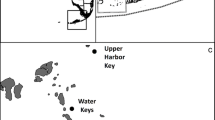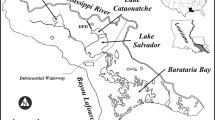Abstract
In brackish lagoons, Daphnia is replaced by calanoid copepods (Eurytemora affinis, Acartia spp.) and rotifers when a certain threshold (depending on, for instance, fish density) is reached. We hypothesize that loss of Daphnia induces a regime shift from clear to turbid at high nutrient concentrations. We conducted a factorial designed enclosure experiment with contrasting salinities (0–16‰), low fish predation (one three-spined stickleback, Gasterosteus aculeatus, m−2) and three levels of nutrient loading in a shallow brackish lagoon. A change point analysis suggests a strong regime shift from a clear to a turbid state at 6–8‰ salinity at low and high loading, but not for the control. From the low to the high salt regime, chlorophyll a (Chla), Chla:total phosphorus (TP) and Chla:total nitrogen (TN) ratios shifted highly significantly for all nutrient treatments, and the bacterioplankton production followed the changes in Chla. These changes occurred parallel with a shift from cladoceran and cyclopoid copepod to rotifer dominance. Monitoring data from 60 Danish brackish lagoons show increasing Chla with increasing TP and TN as well as interactive effects of TN and salinity, peaking at intermediate salinity. A relatively weak effect of salinity at low nutrient concentrations and the stronger effect at intermediate high salinity are in accordance with the experimental results. However, these data suggest a lower salinity threshold than in the experiment, which may be explained by a higher fish density. Our results have implications for the management of coastal lagoons both at present and in a future (predicted) warmer climate: (1) improved water quality can be obtained by reducing the nutrient loading or enhancing the freshwater input to a level triggering a shift to Daphnia dominance (typically <2‰), (2) fish manipulation is probably not a useful tool for brackish lagoons, unless the salinity is below the threshold for a potential shift to a clear Daphnia dominated state, and (3) more abrupt changes will expectedly occur in low-saline coastal lagoons at increasing salinity during summer in a future warmer climate.





Similar content being viewed by others
REFERENCES
Aaser HF, Jeppesen E, Søndergaard M. 1995. Seasonal dynamics of the mysid Neomysis integer and its predation on the copepod Eurytemora affinis in a shallow hypertrophic brackish lake. Mar Ecol Prog Ser 127:47–56.
Aladin NV. 1991. Salinity tolerance and morphology of the osmoregulation organs in Cladocera with special reference to Cladocera from the Aral Sea. Hydrobiologia 225:291–9.
Brooks JL, Dodson SI. 1965. Predation, body size, and composition of plankton. Science 150:28–35.
Carpenter SR. 2003. Regime shifts in lake ecosystems: pattern and variation. Oldendort/Luhe: International Ecology Institute.
Carpenter SR, Kitchell JF, editors. 1993. The trophic cascade in lakes. New York: Cambridge University Press.
Cole JJ, Findlay S, Pace ML 1988 Bacterial production in fresh and saltwater ecosystems: a cross system overview Mar Ecol Prog Ser 43:1–10.
Delbeek JC, Williams DD. 1987 Food resource partitioning between sympatric populations of brackishwater sticklebacks. J Anim Ecol 56:949–67.
Fuhrman JA, Azam F. 1982 Thymidine incorporation as a measure of heterotrophic bacterioplankton production in marine surface waters: evaluation and field results. Mar Biol 66:109–120.
Hanazato T. 1990. A comparison between predation effects on zooplankton communities by Neomysis and Chaoborus. Hydrobiologia 198:33–40.
Hansen AM, Jeppesen E, Bosselman S, Andersen P. 1992. Zooplankton i søer—metoder og artslister. [Zooplankton in lakes—methods and list of species]. Miljøprojekt 205, Miljøministeriet. 43 p (In Danish).
He X, Wright R. 1992. An experimental study of piscivore-planktivore interactions: population and community responses to predation. Can J Fish Aquat Sci 49:1179–85.
Heerkloss R, Schnese W, Adamkiewicz-Chojnacka B. 1991 Seasonal variation in the biomass of zooplankton in two shallow coastal water inlets differing in their stage of eutrofication. Int Revue ges Hydrobiol 76:397–404.
Irvine K, Moss B, Balls H, 1989. The loss of submerged macrophytes with eutrophication II. Relationship between fish and zooplankton in a set of experimental ponds, and conclusions. Freshwat Biol 22:89–107.
Irvine K, Bales H, Moss B, Stansfield JH, Snook D. 1990. Tropic relations in Hickling Broad - a shallow and brackish eutrophic lakes. Verh Int Verein Limnol 24:576–9.
Jakobsen TS, Borch Hansen PB, Jeppesen E, Grønkjær P, Søndergaard M. 2003. Impact of three-spined stickleback Gasterosteus aculeatus on zooplankton and chl a in shallow, eutrophic, brackish lakes. Mar Ecol Prog Ser 262:277–84.
Jakobsen TS, Borch Hansen P, Søndergaard M, Jeppesen E. 2004. Cascading effect of three-spined stickleback (Gasterosteus aculeatus) on the community composition, size, biomass and diversity of phytoplankton in shallow, eutrophic brackish lagoons. Mar Ecol Prog Ser 279:305–9.
Jensen JP, Jeppesen E, Søndergaard M, Jensen K. 1996. Interkalibrering af dyreplanktonundersøgelser i søer. [Intercalibration of zooplankton investigations in lakes] DMU, Miljøministeriet. 43 p (In Danish).
Jeppesen E, Jensen JP, Kristensen P, Søndergaard M, Mortensen E, Sortkjær O, Olrik K. 1990. Fish manipulation as a lake restoration tool in shallow, eutrophic, temperate lakes 2: threshold levels, long-term stability and conclusions. Hydrobiologia 200/201:219–27.
Jeppesen E, Søndergaard M, Kanstrup E, Petersen B, Henriksen RB, Hammershøj M, Mortensen E, Jensen JP, Have A. 1994. Does the impact of nutrients on the biological structure and function of brackish and freshwater lakes differ? Hydrobiologia 275/276:15–30.
Jeppesen E, Søndergaard M, Jensen JP, Kanstrup E, Petersen B. 1997. Macrophytes and turbidity in brackish lakes with special emphasis on top-down control. In: Jeppesen E, Søndergaard Ma, Søndergaard Mo, Christoffersen K, editors. The structuring role of submerged macrophytes in lakes. Heidelberg: Springer. pp 369–77.
Jeppesen E, Jensen JP, Søndergaard M, Lauridsen T, Landkildehus F. 2000. Trophic structure, species richness and biodiversity in Danish lakes: changes along a phosphorus gradient. Freshwat Biol 45:201–13.
Jeppesen E, Søndergaard M, Amsinck S, Jensen JP, Lauridsen TL, Pedersen LK, Landkildehus F, Nielsen K, Ryves D, Bennike O, Krog G, Schriver P, Christensen I. 2002a. Søerne i De Østlige Vejler. Danmarks Miljøundersøgelser. 92 p (In Danish).
Jeppesen E, Søndergaard Ma, Søndergaard Mo, Christoffersen K, Jürgens K, Theil-Nielsen J., Schlüter L. 2002b. Cascading trophic interactions in the littoral zone: an enclosure experiment in shallow Lake Stigsholm, Denmark. Arch Hydrobiol 153:533–55.
Jeppesen E, Jensen JP, Jensen C, Faafeng B, Brettum P, Hessen D, Søndergaard M, Lauridsen T, Christoffersen K. 2003. The impact of nutrient state and lake depth on top-down control in the pelagic zone of lakes: study of 466 lakes from the temperate zone to the Arctic. Ecosystems 6:313–25.
Jürgens K, Jeppesen E. 1997. Cascading effects on microbial food web structure in a dense macrophyte canopy. In: Jeppesen E, Søndergaard Ma, Søndergaard Mo, Christoffersen K, editors. The structuring role of submerged macrophytes in lakes. Heidelberg: Springer. pp 262–74.
Jespersen A-M, Christoffersen K. 1987. Measurements of chlorophyll a from phytoplankton using ethanol as extraction solvent. Arch Hydrobiol 109:445–54.
Jones JI, Waldron S. 2003. Combined stable isotope and gut contents analysis of food webs in plant-dominated, shallow lakes. Freshwat Biol 48:1396–407.
Koroleff F. 1970. Determination of total phosphorus in natural water by means of persulphate oxidation. Interlaboratory report no. 3. Cons. Int. pour l’Explor de la Mer.
Kronvang B, Jeppesen E, Conley DJ, Søndergaard M, Larsen SE, Ovesen NB, Carstensen J. 2005. Nutrient pressures and ecological responses to nutrient loading reductions in Danish streams, lakes and coastal waters. J Hydrol 304:274–88.
Lampert W, Rothhaupt KO. 1991. Alternating dynamics of rotifers and Daphnia magna in a shallow lake. Arch Hydrobiol 120:447–56.
Moss B. 1994. Brackish and freshwater shallow lakes—different systems or variations on the same theme? Hydrobiologia 275/276:1–14.
Muus BJ. 1967. The fauna of Danish estuaries and lagoons. Meddr. Danmarks Fiskeri. og Havundersøgelser N. S. 5. 316 p.
Møhlenberg F. 1995 Regulating mechanisms of phytoplankton growth and biomass in a shallow estuary. Ophelia 42: 239–56.
Ortells R, Reusch TBH, Lampert W. 2005. Salinity tolerance in Daphnia magna: characteristics of genotypes hatching from mixed sediments. Oecologia 143:509–16.
Pace M, Cole JJ, Carpenter SR, Kitchell JF. 1999. Trophic cascades revealed in diverse ecosystems. Trends Ecol Evol 14:483–8.
Pont D, Crivelli AJ, Guillot F. 1991. The impact of three-spined sticklebacks on the zooplankton of a previously fish-free pool. Freshwat Biol 26:149–63.
SAS Institute Inc. 2004. SAS OnlineDoc® 9.1.3 Cary, NC: SAS Institute Inc.
Scheffer M. 1990. Multiplicity of Stable States in fresh-water systems. Hydrobiologia 200: 475–86.
Scheffer M, Hosper SH, Meijer M-L, Moss B, Jeppesen E. 1993. Alternative equilibria in shallow lakes. Trends Ecol Evol 8:275–9.
Scheffer M, Carpenter SR, Foley JA, Folke C, Walker B. 2001. Catastrophic shifts in ecosystems. Nature 413:591–6.
Schindler DW. 1998. Replication versus realism: the need for ecosystem-scale experiments. Ecosystems 1:323–34.
Seber GAF, Wild CJ. 1989. Nonlinear regression. New York: Wiley.
Smits JD, Riemann B. 1988. Calculation of cell production from [3H]thymidine incorporation with freshwater bacteria. Appl Environ Microbiol 54:2213–9.
Solórzano L, Sharp JH. 1980. Determination of total dissolved nitrogen in natural waters. Limnol Oceanogr 25:751–4.
Søndergaard M., Jeppesen E, Aaser HF. 2000, Neomysis integer in a shallow hypertrophic brackish lake: distribution and predation by three-spined stickleback (Gasterosteus aculeatus). Hydrobiologia 428:151–9.
Vadeboncouer Y M, Vander Zanden MJ, Lodge DM. 2002. Putting the lake back together: reintegrating benthic pathways into lake food web models. BioScience 52:44–54.
Vadeboncoeur Y, Jeppesen E, Vander Zanden MJ, Schierup H-H, Christoffersen K, Lodge D. 2003. From Greenland to green lakes: cultural eutrophication and the loss of benthic pathways. Limnol Oceanogr 48:1408–18.
Vander Zanden MJ, Vadeboncouer YM. 2002. Fishes as integrators of benthic and pelagic food webs in lakes. Ecology 83:2152–61.
Vander Zanden MJ, Essington TE, Vadeboncouer Y. 2005. Is pelagic top-down control in lakes augmented by benthic energy pathways? Can J Fish Aquat Sci 62:1422–31.
Worgan JP, Fitzgerald GJ. 1981. Habitat segregation in a salt marsh among adult sticklebacks (Gasterosteidae). Env Biol Fish 6:105–9.
ACKNOWLEDGEMENTS
We wish to thank the staff (Jane Stougaard-Pedersen, Lissa Skov Hansen, Birte Laustsen, Karina Jensen and Kirsten Thomsen) at the National Environmental Research Institute, Silkeborg, for technical assistance in the field and laboratory, and Anne Mette Poulsen and Tinna Christensen for editorial and layout assistance. We are grateful to Mogens Bøgeskov Andersen, Poul Hald Mortensen, Jens Åge Kristoffersen and “The Vorupør dowes” for splendid support in Vejlerne. The study was supported by the Danish Natural Science Research Council (research project “CONWOY” on the effects of climate changes on freshwater), the EU EUROLIMPACS project (http://www.eurolimpacs.ucl.ac.uk) on the effects of climate changes on aquatic ecosystems, the Finnish CARE research project, the EU Marie Curie Center, CREAM, at the National Environmental Research Institute, Roskilde and the Aage V. Jensen Foundation.
Author information
Authors and Affiliations
Corresponding author
Rights and permissions
About this article
Cite this article
Jeppesen, E., Søndergaard, M., Pedersen, A.R. et al. Salinity Induced Regime Shift in Shallow Brackish Lagoons. Ecosystems 10, 48–58 (2007). https://doi.org/10.1007/s10021-006-9007-6
Received:
Accepted:
Published:
Issue Date:
DOI: https://doi.org/10.1007/s10021-006-9007-6




